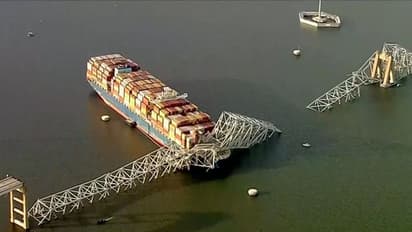CIA-linked cold war era Crane deployed for Baltimore bridge collapse cleanup

Synopsis
A Cold War relic takes center stage in Baltimore's bridge collapse aftermath, as a CIA-linked crane gears up for a monumental debris cleanup.
A powerful floating crane, integral to a historic CIA operation during the Cold War, has been dispatched to aid in the cleanup efforts following the Francis Scott Key Bridge collapse in Baltimore. The crane, known as the Chesapeake 1000, arrived at the Patapsco River wreckage site, signaling a significant step in the recovery process.
Originally constructed as the Sun 800 in 1972, the crane played a crucial role in "Project AZORIAN," hailed as one of the "greatest intelligence coups of the Cold War" by the CIA. This clandestine mission involved the retrieval of a Soviet nuclear submarine that had sunk in the Pacific Ocean.
The crane's capabilities were enhanced over time, with its capacity increased to 1,000 tons, making it a formidable asset in handling heavy debris. Managed by New Jersey-based Donjon Marine Co. Inc., the Chesapeake 1000 boasts impressive dimensions, with a length of nearly 200 feet and a boom reaching 231 feet.
Maryland Governor Wes Moore lauded it as the "largest crane in the Eastern seaboard," underscoring its significance in the cleanup operation. The bridge collapse, triggered by the cargo ship Dali striking a pillar, resulted in six fatalities and left four construction workers missing.
As recovery efforts continue, the Key Bridge Response 2024 Unified Command, comprising various agencies including the Coast Guard and Army Corps of Engineers, remains vigilant in monitoring potential environmental hazards, including spilled oils and hazardous substances.
The CIA's Project AZORIAN serves as a testament to the crane's storied history, highlighting its evolution from a covert Cold War asset to a critical tool in modern-day disaster response and recovery.
Check the Breaking News Today and Latest News from across India and around the world. Stay updated with the latest World News and global developments from politics to economy and current affairs. Get in-depth coverage of China News, Europe News, Pakistan News, and South Asia News, along with top headlines from the UK and US. Follow expert analysis, international trends, and breaking updates from around the globe. Download the Asianet News Official App from the Android Play Store and iPhone App Store for accurate and timely news updates anytime, anywhere.